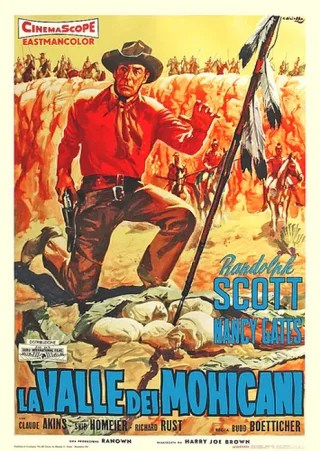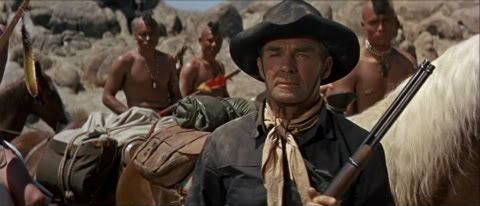Lean and spare are the words often used to describe the westerns of Budd Boetticher and I won’t argue with that. Of course, budgetary constraints were generally the reason for the minimalist approach but Boetticher was masterful at disguising that fact. Burt Kennedy’s drum tight scripting and Boetticher’s control of the camera mean that you never stop to think that what’s on the screen was originally shot as a B picture. Between 1956 and 1960 the director made seven westerns with star Randolph Scott, all but the first produced by Scott’s Ranown. Shooting for the most part around Lone Pine gave these films a distinctive look and feel in much the same way that Monument Valley defined the westerns of Ford. Comanche Station (1960) was their last collaboration and Scott’s penultimate movie.
The plot is quite simple really, and that’s generally the strength of all the Ranown westerns; there’s no excess baggage, and the viewer only sees and hears what is absolutely necessary. Cody (Scott) is a lonely man, a former soldier, who has spent years wandering the west in search of his abducted wife. Whenever he hears a rumor of a white captive he sets off with a mule loaded with trade goods hoping that this time his quest may end. It is said that he’s rescued countless captives but it’s never the right one for Cody. This time will be no different. He trades with the Comanche for the freedom of one Mrs. Lowe (Nancy Gates) and aims to see her safely back to her husband. However, before he can do so, three men turn up and throw a spanner in the works. Lane, Frank and Dobie (Claude Akins, Skip Homeier and Richard Rust) are running from the Comanche, and Cody suspects it’s because they’re scalphunters. Cody’s distrust of Lane dates back to their years in the army, when he had the latter court-martialed for his role in an Indian massacre. It turns out that Mrs. Lowe’s husband has offered a $5000 reward for her return, dead or alive. While the viewer is immediately aware that Cody knew nothing of this, no-one else believes it. The challenge now is for him to save his own skin and that of the woman from both the Comanche and his new companions. As the story progresses it becomes very obvious where the greatest threat lies.
Randolph Scott’s lean and craggy appearance compliments both the landscape and Boetticher’s sparse morality tale. He looks every inch the laconic westerner who’s spent years scouring the scorched, barren land with only his pain and loss for company. The older he got the more adept he became at conveying a kind of buttoned-up emotion combined with an iron sense of personal honor. He was the first actor to draw me to the western as a child, and now I’m more convinced than ever that he may have been the greatest cowboy, surpassing even Wayne and Cooper. In fact all five actors in this film play off each other perfectly, and much of that comes down to the writing of Burt Kennedy. Everyone gets something to get their teeth into and it’s difficult not to feel even some sympathy for all of them. None of the villains in Boetticher’s westerns were ever one dimensional and Kennedy always managed to provide them with enough backstory or characteristic dialogue to keep the viewer interested. Boetticher does a fine job of moving his camera around to offer some unexpected shots and angles, and his use of the wide screen makes what is essentially a small picture look very big indeed.
After what seems like an eternity of waiting, Sony have finally released the five Ranown westerns in their possession onto DVD as The Films of Budd Boetticher. All the films come on their own discs and Comanche Station looks just wonderful. Like the other titles in the set, it boasts a healthy amount of film grain and sports a fine anamorphic transfer with good, strong color. The disc also carries a short featurette with Clint Eastwood offering a few thoughts on the movie. Sony have done a bang up job with this set – I have no hesitation in saying it’s the release of the year for me.


How come there’s been absolutely no comment about such a gem? I have nothing to say about “Comanche Station” save that’s it’s very close to being a masterpiece in the western genre. I once thought “Ride Lonesome” was the crowning achievement of the Boetticher-Kennedy-Scott collaboration. Now I’m not as certain as I used to be and I would favor “Seven Men from Now”. Since I left a comment on this beautiful western, I won’t repeat myself.
LikeLike
This post was ported over from my old site and comes from a time when that blog was relatively new, so comments weren’t as frequent as is the case now. I’m delighted you took the time to seek this out though.
I find it very hard to decide which of these movies is best, and I’ve essentially given up trying to do so as there’s just so much to enjoy in them as a body of work.
The closest I can come is to say I consider Seven Men from Now, Ride Lonesome, The Tall T and Comanche Station as worthy contenders for the top spot.
LikeLike
An appreciation I share with you, Colin. “Ride Lonesome”, “Tall T” and “Comanche Station” are delightful variations on (from?) “Seven Men from Now”, meaning all four movies are all the more enjoyable when you envision them as “a body of work”.
I recently discovered that Budd Boetticher had been honored by a film festival that took place in a small town, twenty miles from where I live, in 1998. Budd was present and I could have seen him in the flesh on this particular occasion, not to mention his movies on a wide screen. Which I did not because I wasn’t aware of it. Shame on me. Same thing happened with Monte Hellman, a few years back, same place. Once again the information didn’t reach me. S…!
By the way, have a Merry Xmas. Looking forward to reading you next year, of course, ’cause it’s always a pleasure.
LikeLike
I can well believe how frustrating it must have been to learn of events like that after the fact.
BTW, thanks for the great feedback. Here’s hoping you have a wonderful Christmas too and have a peaceful and relaxing time over the holiday period.
LikeLike
Pingback: Decision at Sundown | Riding the High Country
Pingback: Ranown in Hi-Def | Riding the High Country
Excellent review of a excellent film. In HD this film just pops. Claude Akins was so good and a wonderful foil for Scott. Boetticher was a Western film God.
LikeLike
Akins fulfilled that bad man role so well, and it is the type of role which is crucial in Boetticher’s westerns. The layering of the villain adds depth to the story and draws the best from Scott’s tortured heroes.
LikeLike
Pingback: Ten Wanted Men | Riding the High Country